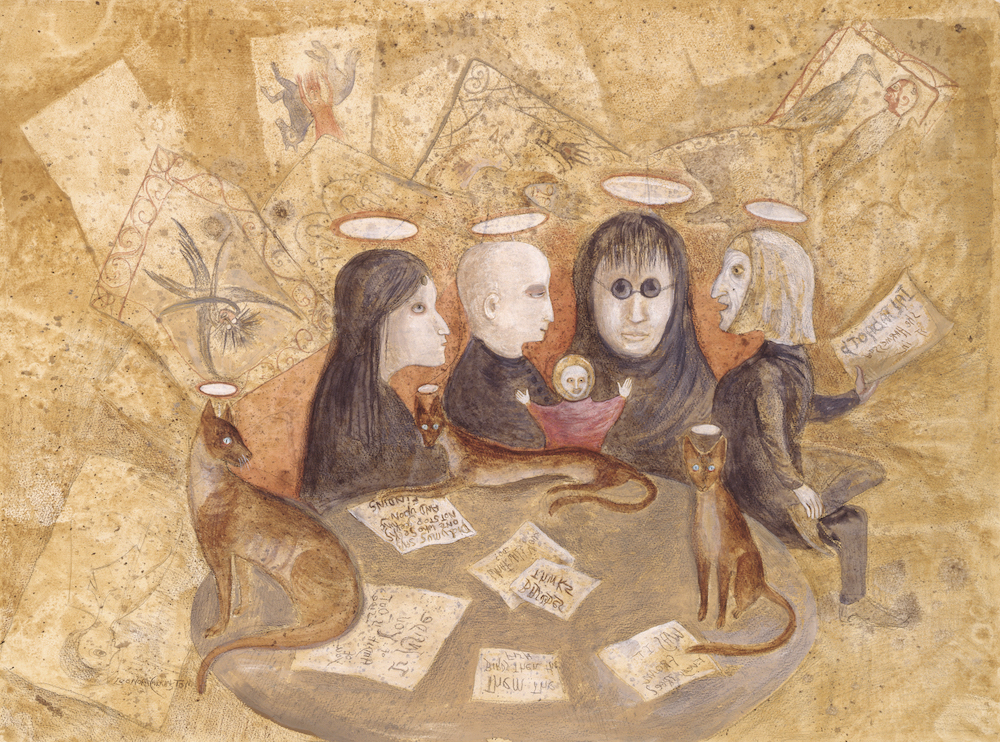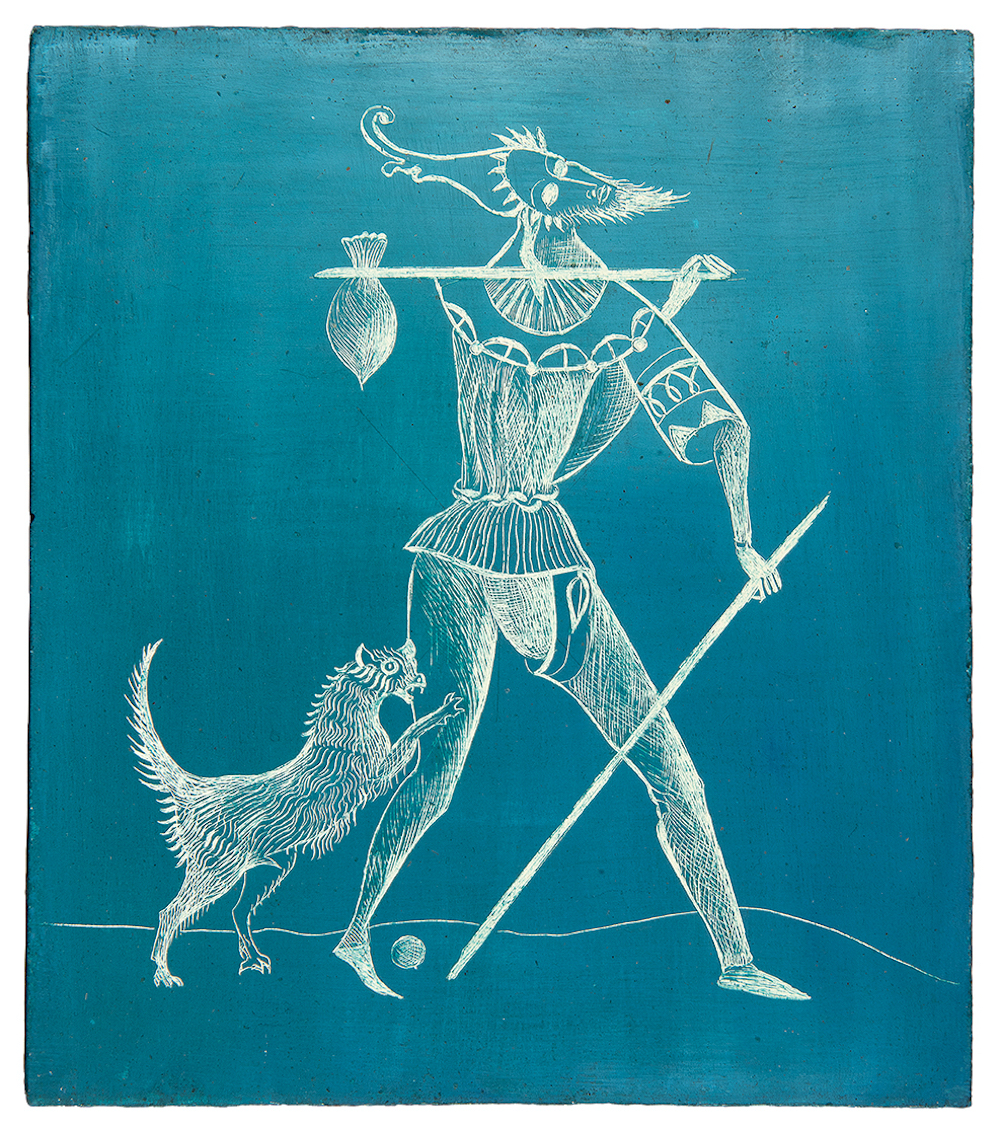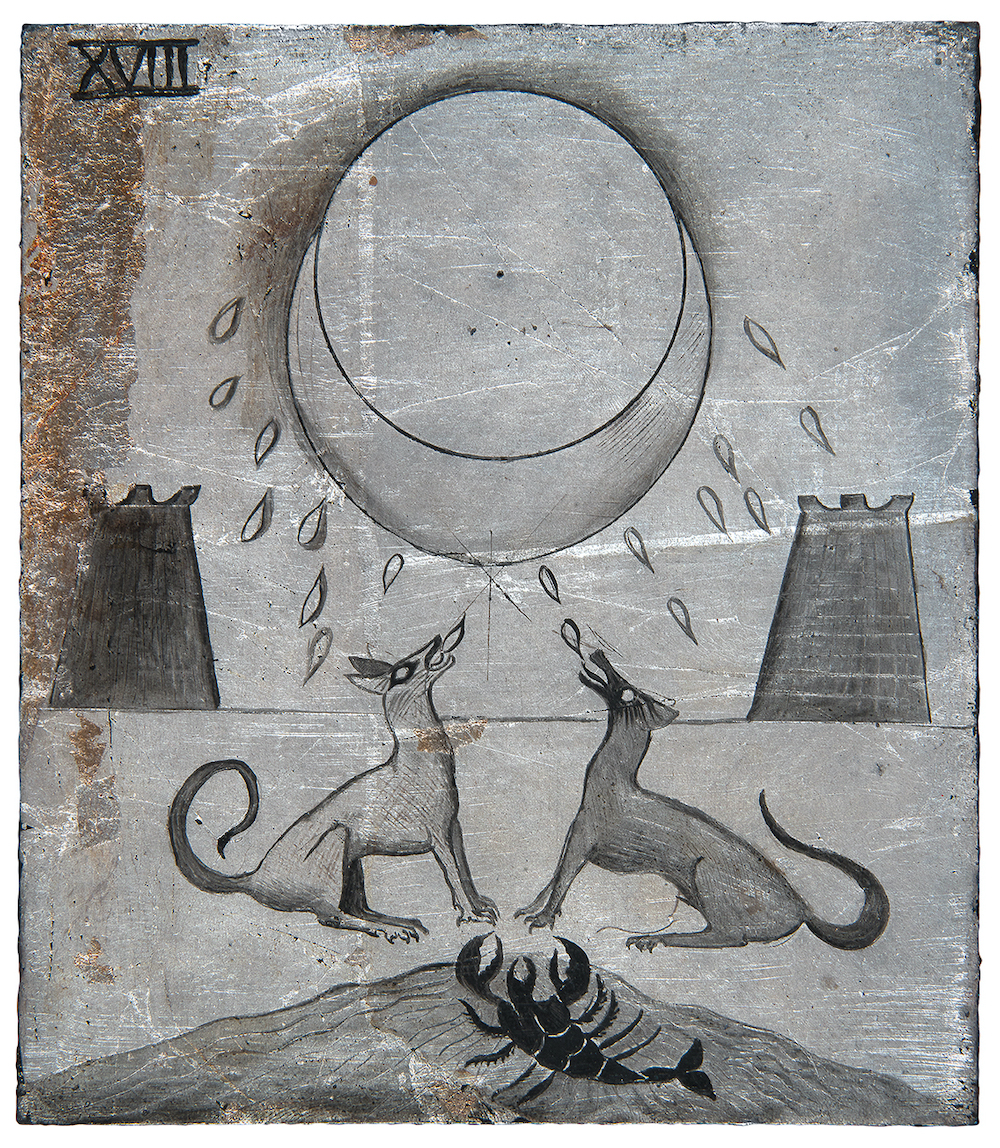
Leonora Carrington, Playing Tarot, ca. 1995, graphite and gouache on paper, 22 x 36 1/4″. Private collection. © Estate of Leonora Carrington / ARS, New York.
“With a mysterious smile on her lips,” writes the Chilean film director Alejandro Jodorowsky, “the painter whispered to me, ‘What you just dictated to me is the secret. As each Arcana is a mirror and not a truth in itself, become what you see in it. That tarot is a chameleon.’ ”
This comes from Jodorowsky’s The Book of Tarot; the painter in question is Leonora Carrington, the British-born, Mexico City–based surrealist famed in life and death as much for her strange, entrancing writings as for her visual art. And this quote appears in another book, Fulgur Press’s The Tarot of Leonora Carrington, which reproduces her newly discovered illustration of the Major Arcana. The tarot is a chameleon, yes, but as Carrington’s vision of it shows, so, too, is it a chance for both the imposition and the abandonment of narrative; in Carrington’s hands, as with her fiction, there is an embrace of the illogical, the fictive, the dream.

Leonora Carrington, The Fool, oil on board, ca. 1955, 6 1/4 x 5 1/2″. Private collection. © Estate of Leonora Carrington / ARS, New York.
Here, the Fool, the beginning of the deck. Card zero. The man strides forward, stick in hand, into the unknown. Some tarot readers call the arc of the Major Arcana the Fool’s Journey, the deck itself the story of this man’s path through life, a metaphor for the human condition. The palette is blue, verging on turquoise; some kind of animal—a dog? a goat?—runs beside the man, nipping at his thigh. In Carrington’s fiction, too, the animal and the human are always interacting in strange ways that blur the boundaries between the two. “Her dressing gown was made of live bats,” goes a line in her short story “The House of Fear,” while in “Cast Down by Sadness,” a character proclaims, “I have a dress made entirely of the heads of cats.” In “As They Rode along the Edge,” a woman makes love to a handsome, doomed boar underneath a mountain of cats. Upon giving birth to “seven little boars,” she keeps the one that most resembles its late father and kills the others, boiling them “for herself and the cats, as a funeral feast.”
The tarot demands a similar sense of porousness. Technically, you’re not supposed to purchase a deck for yourself; to prime your new cards, you’re meant to sleep with them near or under your pillow, a way for the dreamstuff in your head to leak out onto all seventy-eight cards. The tarot consists of two kinds of cards, the Major Arcana and the Minor Arcana. Think of the Major in terms of Jungian archetypes, big energies, figures borrowed from and repeated in mythoi the world over. The Minor, made up of four decks—Cups, Wands, Pentacles, and Swords, possibly cribbed from a Renaissance Italian card game—can be thought of as lower echoes of the same forces embodied by the Major Arcana. I’ve bought all my own decks, which is perhaps unlucky, but I’ve been in the mood to take fate into my own hands. This is what it feels like when I read for friends, like I’m shuffling fates—like Clotho spinning her thread. “Use this as a guide,” I warn them. “It’s just a tool, a method of clarification. You still have free will.”
Carrington was well aware of the power of one’s free will. She took her fate in her own hands when, at the age of twenty, she ran off with the artist Max Ernst, abandoning the life laid out for her by her wealthy family. “There’s no proper ending to this story,” concludes another of her tales, this one from the early fifties. “There’s no ending because the episode is true, because all the people are still alive, and everyone is following his destiny.”
The element of choice is there also in her version of the Lovers, that shadowy second meaning so often willfully overlooked by those intent on seeking love. A male figure stands between two women; a sharp-edged, faceless Cupid—love is blind, after all—readies his decision-making bow. The Lovers—the card of Gemini, the two-faced twins—can be a card of passionate, heady partnership, of complementary energies and attraction in all its forms, but rarely is it a card of total devotion. Love and sex do not always square with commitment and longevity, and this is part of the slipperiness of the Lovers: the card of love, the card of decisions, the possibility of paths diverging.
Carrington’s Hanged Man is one of the loveliest versions I’ve seen, all purple and gold, with its odd message of surrender. The Hanged Man is also a card of crossroads, of biding one’s time; it pictures a man strung up by his heels and hung upside down, as was once done to traitors in Renaissance Italy. The pittura infamante, they called it: a “defaming portrait” of a thief, a fraud, a swindler. But I’ve also read of the card’s association with Odin, that mysterious Viking god who hung himself upside down from a tree for three days in order to gain wisdom. Animal or human sacrifices made in Odin’s honor were also strung up from trees, in groups of nine, swaying in ghostly sacred groves. Or maybe it’s a portrait of Judas, betrayer of Christ. In Carrington’s version, the hanged man stares out calmly, a slight smile on his face. It is a card of thresholds, of doorways, of change in the air—but not yet. It is a card of holding off decisions, letting time decide what it will.
The Hanged Man always makes my mind drift to Hecate, the Greek goddess of crossroads; also, the moon. Also, the Moon—that is, the card marked number eighteen in the deck. Carrington’s rendition of the Moon is silvery and dominated by twos: two towers that look like the upright, not-yet-fallen version of the Tower, the card of destruction and necessary change; two dogs, howling; two pincers of a scorpion—Scorpio?—raised at the two points of the crescent moon as it combines with a full circle. Something strange happens whenever there’s a full moon, a kinetic energy in the air. We all know but can’t explain it. Yesterday morning, a friend told me she’d just realized what day it was that she’d gotten into a big fight with her partner last month. She had checked her journal and her calendar. She couldn’t believe it. The full moon.

Leonora Carrington, The Moon, ca. 1955, oil and silver leaf on board, 6 1/4 x 5 1/2″. Private collection. © Estate of Leonora Carrington / ARS, New York.
Writing, like tarot, like painting, is an attempt to impose order on what is fundamentally without order. Yet even the results of these transformations, these transubstantiations, this alchemy of changing thought into a more concrete form of expression, cannot fully escape their origins. Freudian slips, puns, free associations, automatic writing, automatic drawing—the unconscious rears its head. And so, too, with a tarot reading must one piece together a story from the symbols presented. The most famous type of tarot spread, the Celtic Cross, offers past, present, the immediate future, one’s motivations, the motivations of another, and the final outcome, its ten cards resembling nothing so much as the structure of fiction.
I pulled a tarot card just before I wrote this paragraph. I wanted some kind of answer, though the question was abstract, something along the lines of, What should I know to end this essay? After shuffling, when it felt right—you just know—I pulled the Three of Swords and breathed in sharply. This is not a card that appears in Carrington’s tarot—it’s from the Minor Arcana—but the second card I pulled as a clarifier, the Star, is.
The Three of Swords is a card, quite literally, of endings. It’s most often associated with the end of a romantic relationship, a betrayal of some sort, and in its traditional imagery, three swords pierce a heart. It is not a particularly happy card. But the Star, often associated with Aquarius, provides a message of hope. In Carrington’s gold-and-blue imagining of it, a woman pours two jugs of water into the ground; it’s beautiful, but it’s also a little odd. In combination, the message of these two cards is clear, isn’t it? Time to finish the damn essay. And with that—finis.
Rhian Sasseen is the engagement editor of The Paris Review. Her work has appeared in 3:AM Magazine, Literary Hub, The Nation, and more.
from The Paris Review https://ift.tt/39NyuAp
Comments
Post a Comment